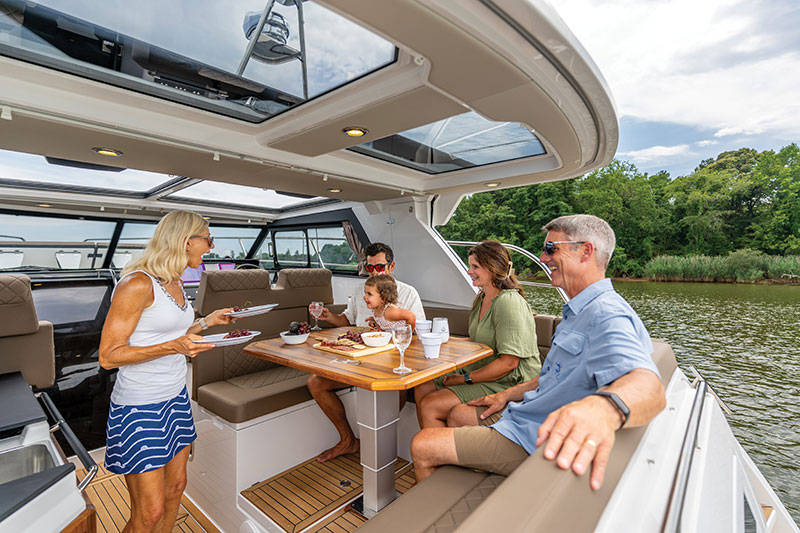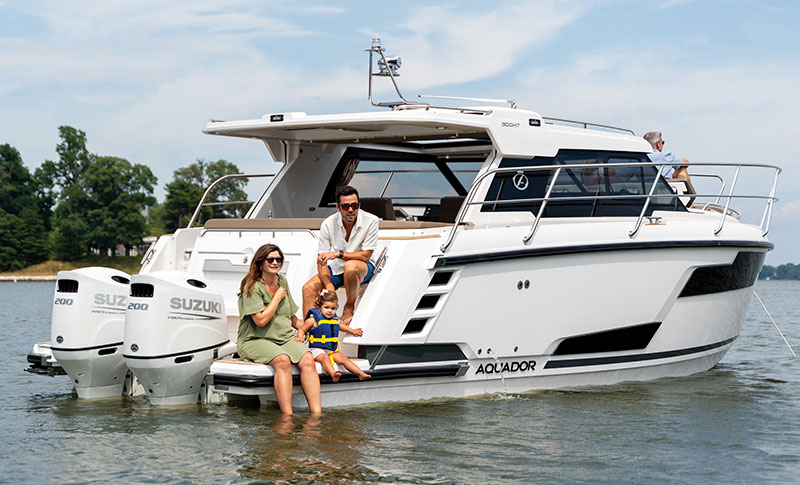Scandinavian invasion.
by Charles Plueddeman
In the early 1960s, the “British Invasion” changed the sound of pop music in America.
Photos Courtesy of Aquador
Today, an invasion of Scandinavian designs is changing the look of pleasure boats on our waters.
This latest “invader,” the Aquador 300 Hard Top (HT), originates from Finland and sports the near-plumb stem — a ubiquitous feature of designs from Northern Europe like Saxdor, BRABUS, Fjord, Jeanneau, Axopar and Nimbus. This look is now migrating to American brands, from the Euro influence of Groupe Beneteau on the Wellcraft nameplate to the latest models from Bayliner and Monterey.
Our afternoon on the waters of Lake Michigan proved there is more than a plumb stem to the Aquador 300 HT. This is a family cruiser loaded with many great design details.
The 32-foot, 9-inch 300 HT model was launched by Bella Boats under its Aquador brand in 2022. Since 2018, Bella Boats has been part of the Nimbus Group, based in Sweden. Aquador currently offers the 300 HT and the 25-foot 250 HT model, which are now both available in North America through a distributor agreement with the franchised fractional membership organization PowerTime Boat Club. Aquador boats will be sold into PowerTime fleets for shared usage and will also be offered to retail buyers, with PowerTime acting as the dealer and a local franchisee handling service. The Aquador 300 HT we tested in September is the first boat available through PowerTime Door County in Sturgeon Bay, Wisconsin.
Designed from the inside out
 Aquador says the 300 HT model was designed from the inside out, so we began our walkthrough from the cabin. Headroom is excellent at about 6 feet, 1 inch throughout the cabin with full-length sidelights and a large overhead hatch providing plenty of daylight. Woodwork in the cabin is all beautifully finished walnut. There’s a settee to port that extends below the berth so that it can double as a child’s bunk, and a space on the forward bulkhead is intended for an owner-installed flat-screen TV. The V-berth is 6 feet, 4 inches long — clearly this is a cabin designed to accommodate tall adults in comfort. A walk-in head features a glass bowl sink, a flushing commode, a hand-held shower, a sidelight with port and a cabinet below the sink. Just abaft the head is a private mid-cabin with a settee, a closet and a full-size berth. Headroom here is also more than 6 feet, and a sidelight emits lots of daylight. This could be a very comfortable living space for weekending with family or two couples.
Aquador says the 300 HT model was designed from the inside out, so we began our walkthrough from the cabin. Headroom is excellent at about 6 feet, 1 inch throughout the cabin with full-length sidelights and a large overhead hatch providing plenty of daylight. Woodwork in the cabin is all beautifully finished walnut. There’s a settee to port that extends below the berth so that it can double as a child’s bunk, and a space on the forward bulkhead is intended for an owner-installed flat-screen TV. The V-berth is 6 feet, 4 inches long — clearly this is a cabin designed to accommodate tall adults in comfort. A walk-in head features a glass bowl sink, a flushing commode, a hand-held shower, a sidelight with port and a cabinet below the sink. Just abaft the head is a private mid-cabin with a settee, a closet and a full-size berth. Headroom here is also more than 6 feet, and a sidelight emits lots of daylight. This could be a very comfortable living space for weekending with family or two couples.
The cockpit of the 300 HT is designed to be a welcoming social space. The standard hardtop extends aft to shade the entire area, but large side windows and four glass panels in the top keep the space very bright and airy when that’s desired. The two forward glass panels open and all are fitted with pull-out sunshades. A bench seat surrounds a central teak table with a folding top. The table can be raised or lowered on an electric pedestal; when in its low position, it can be covered with cushions to create a third berth.
The galley is to port, and our test boat was equipped a sink and a two-burner convection range powered by diesel fuel. When not in use, both the sink and range may be covered by a hinged hard surface to form a wide countertop. An 85-liter slide-out refrigerator is located below the sink, with abundant storage in drawers and cabinets. There is no microwave on the boat. Our boat featured heat and AC for the cabin and cockpit. The entire cockpit can be enclosed by sliding clear curtains out of the aft sail panels and securing them together with a center zipper.
The helm is elevated from the cockpit sole, which creates that excellent headroom in the mid-cabin below but makes for rather tight headroom at the wheel. You’ll sit at the controls — unless you open the glass panel overhead, which allows almost any adult to stand at the wheel and look out above the hardtop. This is actually fun when the weather is nice and affords excellent visibility around the dock.
Helm features include a pair of 12-inch Simrad NXT displays plus smaller Suzuki displays for each engine, an optional joystick for the Suzuki engines, a display to monitor the solar-power charging system, a joystick for the bow thruster, a control for Zipwake interceptors and a Simrad VHF. A covered stowage compartment on the dash top features two wireless device chargers.
 The great outdoors
The great outdoors
Passage to the bow is via port and starboard walkways accessed up steps from the transom platform. Each is only 7 inches wide, but a full-length railing and grabrails on the hardtop help steady the way. Our boat had an optional sunpad over the cabin top. Eco Teak covers the rest of the foredeck, walkways, the transom platform and the cockpit sole. Synthetic decks are also available.
The transom platform extends more than 4 feet outboard the motors with 20 inches of walking space forward the outboards. With sterndrive power, you’d get the full, uncluttered platform with sockets for a small table and a fold-down seat from the transom. With outboard power, a large dunnage box is built into the transom with room for wet lines and fenders. The entire aft cockpit sole lifts open on an electric strut; because there is no engine below, much of that space can be used for stowage, and there’s a molded tray to keep gear out of the bilge. Lift out that tray for excellent access to all systems and fittings, including a pair of Relion RB300 300-amp hour LiFe house batteries, which can be charged by shore power or a pair of 55-watt solar panels on the hardtop through a MasterVolt battery management system.
Handling and performance
Our test boat was powered by a pair of Suzuki DF200 outboards. A pair of Mercury Verado 200 outboards are also a power option, as is a single 320-hp diesel Volvo Penta D4-DPI Aquamatic sterndrive. The 300 HT has a beam of 10 feet, 6 inches and a displacement of just under 10,000 pounds. These power options might seem a bit modest by American standards but are typical for Europe where fuel costs are much higher.
After waiting for a bridge to open, we took a quick run east toward Green Bay. The Aquador Aquadynamic running surface has a rather flat 18-degree deadrise at the transom but still delivered a smooth ride over a brisk chop. To create the spacious cabin, the boat has a rather chunky profile with very high freeboard, plus the hardtop, and the rather flat bottom likely improves stability at rest. The 300 HT heels way over in a hard turn but tracks well. Gyro stabilizers are also available as an option.
With a light load of gear and passengers, we recorded a top speed of 39.4 mph (34.2 knots) and a 0-to-20 mph time of about 12 seconds. Economy was excellent at 1.5 statute mpg from 4500 to 5500 RPM (23 to 36 mph), for a cruising range of about 169 miles from the 125-gallon fuel tank. Base price with all shipping and duties and twin Suzuki motors is about $340,000, and with options our boat was priced at about $376,600. We think the 300 HT is well-suited for three-season boating on the Great Lakes. Once you get used to the limited headroom at the helm — an acceptable compromise for the generous headroom below decks — this Aquador combines clever, efficient design with outstanding Finnish detailing, making it an intriguing new option for family dayboating and light cruising.

Generous headroom below decks, with a mid-cabin designed for adult comfort
Cockpit is bright and airy thanks to glass panels in the hardtop, yet easy to button up for foul weather
Excellent access to batteries and fittings in the bilge
Specifications
- LOA: 32’9″
- Beam: 10’6″
- Dry Weight: 9,921 lbs.
- Fuel Capacity: 125 gals.
- Water Capacity: 37.5 gals.
- Power (as tested): 2 X Suzuki DF200 outboards
- Price (as tested): $376,645
- Website: aquadorboats.fi
Dealers
- PowerTime Boating
Chicago, IL; Door County, WI; Milwaukee, WI
powertimeboating.com


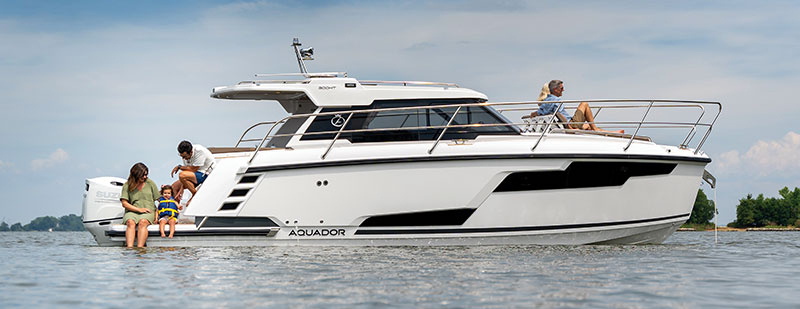
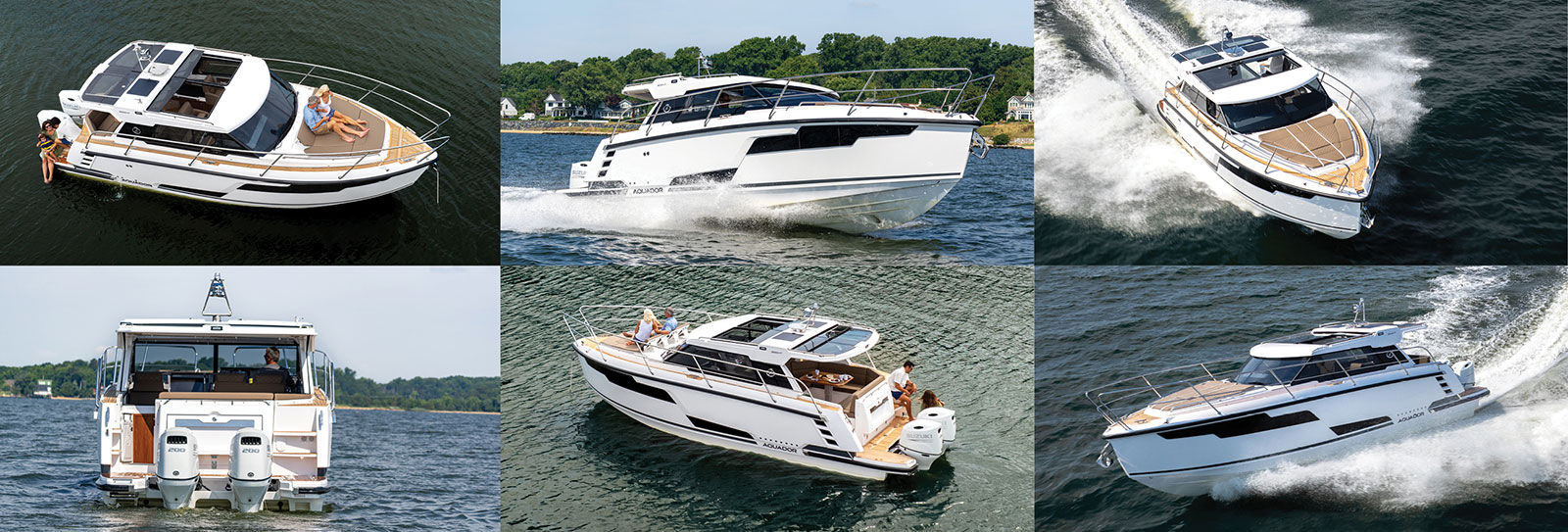
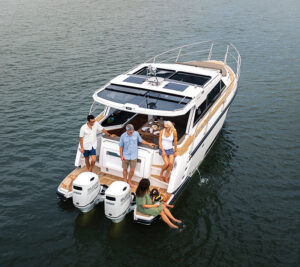 The great outdoors
The great outdoors

